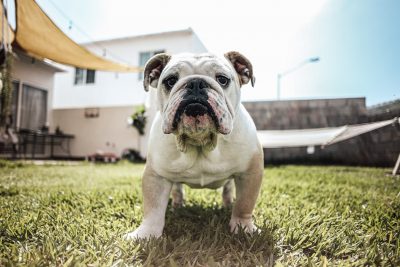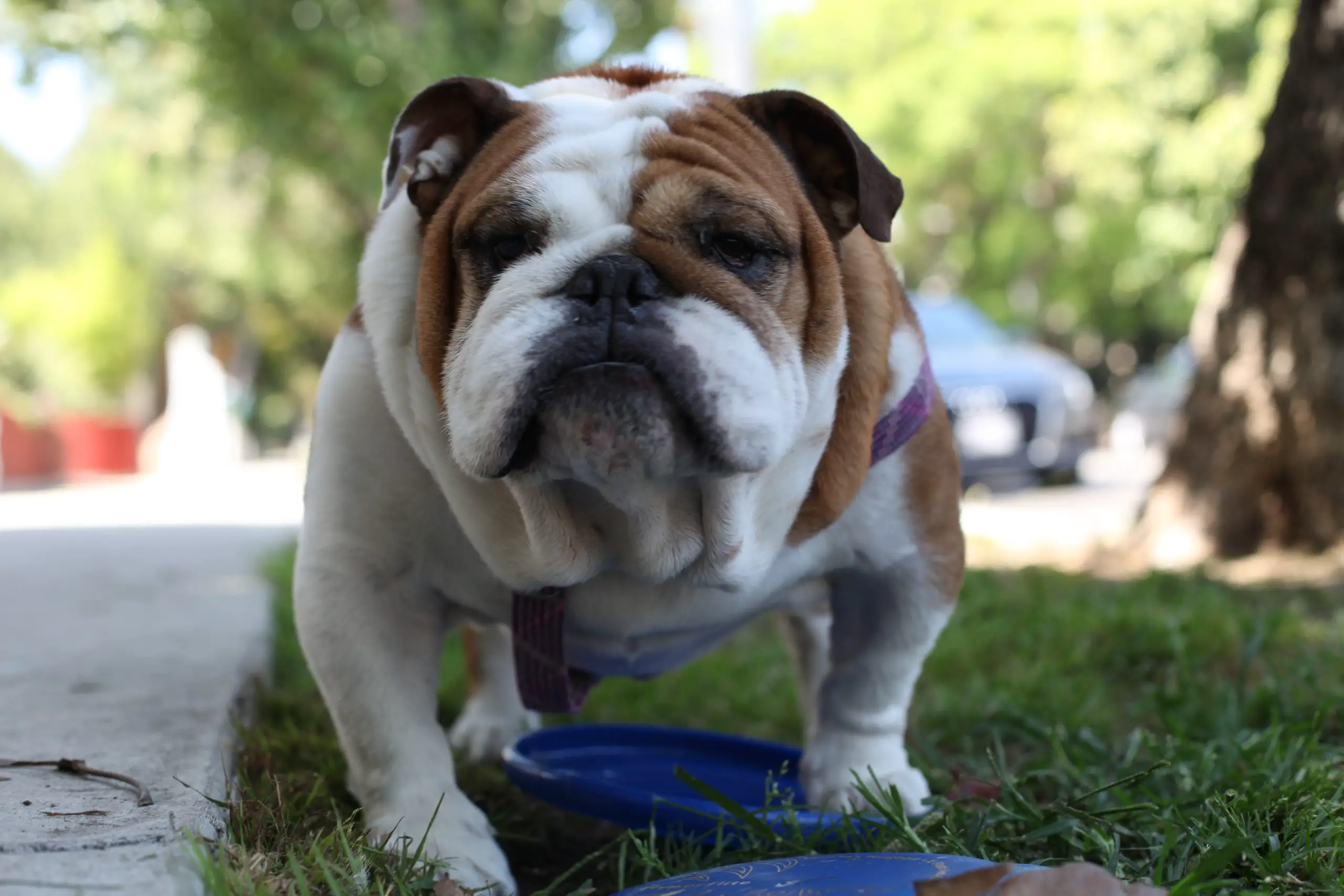Left unattended with unlimited access to food, bulldogs have a tendency to eat everything in sight to the point that they become ill. With their sensitive tummies, you must keep a close eye on what your bulldog is eating.
From puppyhood to adulthood, the right amount of food served the right number of times a day can make all the difference in helping your pet live a longer, happier, and healthier life.
Best Food for Bulldogs
Before looking into what they need to be fed, it’s a good idea to understand the nutritional needs of bulldogs.
A standard-sized bulldog weighing about 50 pounds with an active lifestyle should have an average daily calorie intake of 1,358. Depending on the size, weight, and activity levels of your dog, your bulldog may need more or fewer calories. Your dog’s metabolism will also influence your canine’s ideal calorie intake.
Regardless of where the food comes from, the best food for bulldogs should always have adequate percentages of the nutrition they need. Your food can be commercially bought kibble, homemade, canned, or raw as long as it fulfills this condition.
This means that you should always read the nutrition labels to find out if the food you’re about to give your dog has the right percentage of nutrients.
The best food for bulldogs should always have the following in every meal:

#1. Proteins
Premium proteins are one of the non-negotiable components that should always be present in their diet.
With adult bulldogs, at least 18% of protein should be incorporated into their meals. Bulldog puppies on the other hand need at least 22% of maintenance proteins.
You can add more proteins too since they use this compound to build muscle as well as keep healthy and strong.
Note that there are protein sources that can trigger your bulldog’s allergies. If this is the case, the best protein source you can use is lamb. Lamb is a lean delicious meat that’s packed with amino acids.
If your bulldog doesn’t suffer from allergies, you can use pork, beef, turkey, chicken, and fish for protein.
Recommended Reading: We’ve created a list of our top picks for high-protein dog foods that you might be interested in.
#2. Fats
When we say fats, we mean good fat because bulldogs are susceptible to weight gain and obesity.
Fat is an essential source of energy. It’s also a great source of flavor and makes food much more appetizing for your dog. At least 5% of your adult bulldog’s daily diet should be made up of fat. For puppies, fat should be at 8%.
When trying to decide how to incorporate fat into your bulldog’s diet, go for omega fatty acids. You can also use the natural fat from your protein.
#3. Carbohydrates
For your bulldog to be full of energy, you need to incorporate carbohydrates in your dog’s meals. However, keep in mind that it isn’t an essential component in making your bulldog or any other dog breed for that matter healthier.
This might come as a surprise because most commercially available dry dog food has carbohydrates as a dominant ingredient.
Nevertheless, having a percentage of carbohydrates in your dog’s food is still recommended but you should always choose meals with a higher meat-based protein percentage and low carbs rather than the other way around.
#4. Vitamins and Minerals
This dynamic duo is usually found in fruits and vegetables. Unfortunately, dogs aren’t usually fans of this food category. Vitamins and minerals help support your bulldog’s immune system, enhance their cardiovascular health, and protect them from free radicals.
Dog meals typically have small percentages of fruits and vegetables mixed in. To supplement their fruit and veggie intake, you can offer them blueberries, raspberries, or kale as treats.
#5. Water
Water is important because of bulldogs’ unique anatomies. They are brachycephalic canines which means that they have short muzzles and noses which can make breathing more challenging.
By making sure that the meals you feed your bulldog have sufficient liquid, you’ll be making them easier and safer for your dog to consume. If you typically serve your dog dry food like kibble, add some water to it as a quick fix.
Supermarkets and pet stores have a wide array of brands and variants with which you can feed your dog. When trying to decide on which to feed your bulldog, it’s always a safer bet to choose premium brands and those with established reputations. If in doubt, you can also discuss your dog’s nutritional needs with your veterinarian.
Bulldog Homemade Food
Just as it is with us humans, home-cooked meals for your bulldog have more benefits. It might take more time and energy, but you can make big batches and store leftovers in your freezer.
Some of the benefits of home-cooking your bulldog’s meals are:
- It promotes better and healthier eating habits for your dog.
- You control the ingredients and nutrition that go into your dog’s food. If, for example, you wanted to go organic, you can use fresh and organic ingredients only.
- It’s cheaper than commercially available food.
- You can make more precise adjustments to the meal portions based on your bulldog’s size and weight. This makes it easier to ensure that your canine’s dietary requirements are met in every meal.
- Homemade dog food will be easier for your bulldog’s tummy to digest.
Have we convinced you yet? You can try this nutritious and flavorful recipe for a strong and appreciative bulldog.
This recipe uses plenty of ingredients, but it’s meant to provide your bulldog with complete nutrition so your pet can be strong and healthy. Here’s what you need to have:
A Nutritious and Delicious Mix for Bulldogs
- 3 pounds ground turkey
- 1 cup uncooked brown rice, millet, or quinoa
- 1 tablespoon olive oil
- 1 medium-sized carrot, shredded
- 1 medium-sized zucchini, shredded
- 1 medium-sized squash, shredded
- 1 medium-sized apple, chopped
- 1 tablespoon of calcium powder
- ¼ cup of coconut flakes, unsweetened
- ½ cup of pumpkin puree, unsweetened
Directions:
- Cook the brown rice (millet or quinoa) as directed. You can add more water for a softer texture.
- Cook the ground turkey in olive oil until browned. Drain the leftover fat and set it aside to cool.
- Once the brown rice and the ground turkey have cooled to room temperature, add the shredded vegetables, coconut flakes, and puree.
- Mix until you get a good mash.
- Split into portions and keep the rest in the freezer so you have meals for the next few weeks.
Recommended Reading: We’ve written a whole article on homemade dog foods that you might be interested in.
Bulldog Food Amount and Schedule
Bulldogs are eating machines so it’s up to you to control the amount of food your canine consumes daily. The question now becomes: what’s the ideal eating schedule and serving size for my bulldog?
For adult bulldogs, a twice-a-day feeding schedule during breakfast and dinner is sufficient. A maximum of 2 cups of kibble can be provided to them for every meal. You can of course adjust this serving size based on your dog’s weight.
If you feel that it’s too little, don’t forget that aside from breakfast and dinner, your dog also gets treats in between. This too affects your pet’s daily nutritional needs.
An obese dog is not a healthy dog.
Food Schedule for a Bulldog Puppy

Nutrition for puppies is critical during the first 12 to 18 months because this is the development stage. They’ll need to get as much healthy food as possible to thrive and grow.
Refer to the feeding schedule below for bulldog puppies 1, 3, and 6 months old.
Food Schedule for a 1-Month Old Bulldog Pup
At four weeks, your pup should still be with the mother and littermates.
Your puppy is still mostly reliant on mother’s milk and may not be ready to try puppy food yet. You can try to introduce semi-solid food, but it’s okay if it gets rejected. All the calories that your month-old bulldog needs can still be adequately provided by the mother.
In cases where the mother isn’t around to provide milk and your puppy isn’t ready to transition to puppy food, you’ll have to bottle feed your pup with a milk replacement formula. As you transition to solid food, you can make a soupy meal by combining mashed kibble with warm water.
The average 1-month old bulldog pup needs an ounce of formula for every 8 ounces of body weight daily. Spread out the daily portions into 4 separate feedings.
As your pup gradually transitions to solid food, you can make a soupy meal with mashed kibble mixed with warm water.
Food Schedule for a 2-Month Old Bulldog Pup
By the time your pup reaches 2 months, your bulldog will be completely weaned from mother’s milk and should be eating puppy food. A healthy weight for bulldogs at this age is around 11 pounds or 5 kilograms.
A 2-month old bulldog puppy will need about 1.5 cups of puppy food every day. This amount should be divided into three meals.
Food Schedule for a 6-Month-Old Bulldog Pup
This is the ideal age to transition your bulldog to two meals a day. You can start with feeding your puppy three times a day, then gradually reduce the midday meal until you can remove it completely.
At this stage, a 6-month old bulldog will need 3 to 4 cups of kibble spread over two meals. This can be more or less as you take into account your dog’s weight, size, metabolism, and overall lifestyle.
Conclusion
Even at a young age, bulldogs should not be indulged with “free-feeding” or allowing them to eat whenever and as much as they like because it can easily lead to obesity.
Setting limitations on the amount of food, following a regular feeding schedule, and ensuring that you’re meeting your dog’s daily nutritional needs will give you the best chances at a long and healthy life together.








